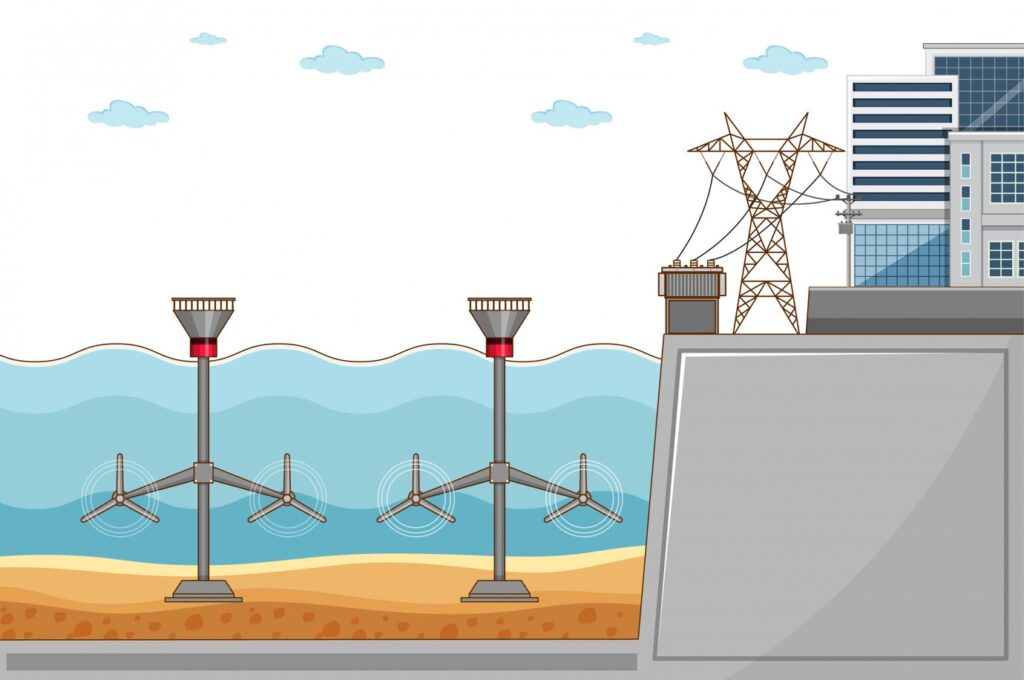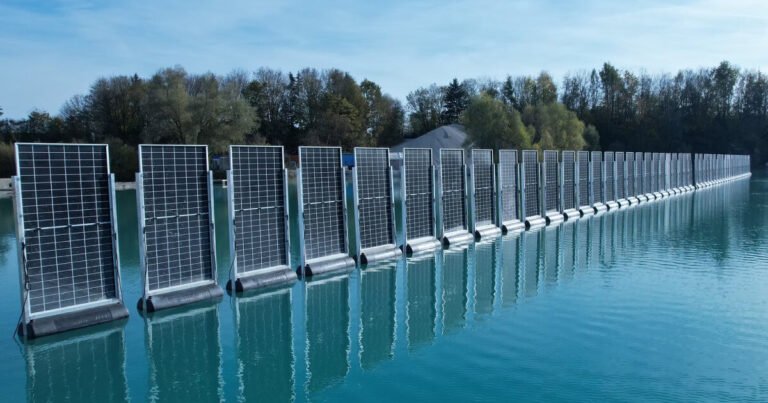Pros and Cons of Tidal Energy
France’s La Rance Tidal Power Plant has been generating clean energy since 1966. It’s one of the world’s oldest and most successful tidal power stations, producing 540 GWh of electricity annually—enough to power 250,000 homes. That’s an entire city running on the power of the ocean’s natural rhythms.
This kind of reliability is what makes tidal energy so exciting. While solar panels rely on the sun and wind turbines depend on changing wind speeds, the tides are steady and predictable. Every single day, without fail, the ocean moves in and out. The question isn’t whether the tides will come—it’s how well we can capture their energy.

In This Article
- What is Tidal Energy, and Is It Renewable?
- Pros of Tidal Energy
- Cons of Tidal Energy
- Future of Tidal Energy: Challenges and Opportunities
- Actionable Advice: Should Your Country Invest in Tidal Energy?
- Conclusion
What is Tidal Energy, and Is It Renewable?
Tidal energy, also known as tidal power, is electricity generated from the natural rise and fall of ocean tides. It works because of the gravitational pull of the moon and the sun on Earth’s waters. Unlike fossil fuels, which can be exhausted, tides will continue as long as the moon orbits our planet. This makes tidal energy a truly renewable source of power.
There are three main ways to capture tidal energy:
- Tidal Barrages – These are large dam-like structures built across estuaries. As water moves in and out with the tide, it passes through turbines, generating electricity. One of the best-known examples is the La Rance Tidal Power Plant in France.
- Tidal Stream Generators – These work like underwater wind turbines. Instead of air, they use fast-moving tidal currents to spin turbines and generate electricity. These are less intrusive than barrages and can be placed in deep waters.
- Dynamic Tidal Power (DTP) – This is a more experimental idea. It involves building long dams perpendicular to the coast to take advantage of tidal waves on both sides of the structure. While promising, no full-scale DTP project has been built yet.
Pros of Tidal Energy
1. Predictable and Consistent Energy Source
One of the standout features of tidal energy is its predictability. Unlike wind or solar power, which can be intermittent due to changing weather conditions, tides follow a natural and consistent rhythm influenced by the gravitational pull of the moon and the sun. This means we can forecast tidal patterns years, even decades, in advance, making energy planning more reliable.
For instance, the Severn Estuary in the UK has one of the highest tidal ranges in the world. Experts have identified this area as a prime location for tidal energy projects, capable of contributing up to 7% of the UK’s electricity needs. The Severn Estuary Commission emphasises the urgency of harnessing this predictable energy source to meet increasing electricity demand and reduce carbon emissions.
2. Low Carbon Footprint
In our fight against climate change, reducing carbon emissions is crucial. Tidal energy stands out as a clean alternative, producing zero direct carbon emissions during operation. While there are emissions associated with the construction phase, they are minimal compared to fossil fuels. A study published in Heliyon estimates the Global Warming Potential (GWP) of a tidal farm to be approximately 42.11 grams of CO₂ equivalent per kilowatt-hour (g CO₂eq/kWh) over its lifecycle.
For context, data from the U.S. Energy Information Administration (EIA) indicates that in 2019, coal-fired electricity generation produced about 2,257 pounds of CO₂ per megawatt-hour (MWh) of electricity. This translates to approximately 1,024 grams of CO₂ per kilowatt-hour (g CO₂/kWh), highlighting the substantial environmental benefits of transitioning to tidal power.

3. Long Lifespan of Infrastructure
Investing in energy infrastructure is a significant commitment, so longevity matters. Tidal power plants are built to last. Many have an expected lifespan ranging from 50 to 100 years, surpassing other renewable energy installations like wind farms, which typically last around 20 years. A notable example is the La Rance Tidal Power Plant in France, which has been operational since 1966 and is still generating electricity today. This durability translates to long-term energy security and better returns on investment.
4. Energy Independence for Coastal Communities
For coastal and island communities, energy independence is a game-changer. Relying on imported fossil fuels can be costly and subject to geopolitical tensions. By tapping into local tidal resources, these communities can generate their own electricity, reducing dependence on external energy sources. Scotland, for example, has been investing in tidal energy projects to harness the power of its coastal waters, aiming to bolster local economies and achieve greater energy autonomy.
5. Job Creation and Economic Growth
Beyond their environmental advantages, tidal energy projects can significantly boost local economies by creating jobs in construction, engineering, and maintenance. For example, the proposed Mersey Tidal Power Project in Liverpool aims to generate 700 megawatts (MW) of electricity and create numerous green jobs, contributing to Liverpool’s ambition to become a renewable energy hub.
Similarly, the Tidal Lagoon Swansea Bay project in Wales was projected to sustain over 2,200 construction and manufacturing jobs during its development phase.
In the United States, the Ocean Renewable Power Company’s (ORPC) tidal energy project in Maine injected $14 million into the local economy and supported more than 100 local and supply chain jobs.
6. Minimal Visual Impact
A common concern with some renewable energy installations is their visual impact on landscapes. Tidal turbines are typically submerged underwater, making them less obtrusive than wind turbines or large solar farms. This characteristic makes tidal energy an appealing option for areas where preserving natural scenery is a priority.
7. Technological Advancements and Reliability
The tidal energy sector has been evolving, with technological advancements improving reliability and efficiency. Since 2003, tidal stream energy deployments have accumulated around 1.4 million operating hours. Studies indicate that the empirical failure rate of tidal energy systems is comparable to that of the wind industry at a similar stage of development. This growing reliability boosts confidence in tidal energy as a dependable power source.
Learn More: Is Natural Gas Renewable or Nonrenewable Resource?
Cons of Tidal Energy
1. High Upfront Costs
Embarking on a tidal energy project is no small financial feat. Constructing tidal barrages and installing underwater turbines demands significant investment. To put it in perspective, generating electricity from tidal energy can cost between $0.30 and $0.50 per kilowatt-hour (kWh), whereas wind energy ranges from $0.05 to $0.15 per kWh. This stark contrast often makes potential investors hesitant.
Take the proposed tidal lagoon in the Severn Estuary, for instance. The UK Government’s Severn Tidal Power Feasibility Study (STPFS) in 2010 estimated that such a project could cost as much as £34 billion. The study concluded that it would be a high-cost, high-risk endeavour compared to other low-carbon electricity generation methods and would likely require substantial public sector investment due to challenges in attracting private funding.
2. Geographical Limitations
Tidal energy isn’t universally applicable. Its viability hinges on locations with strong tidal currents. Globally, only about 40 to 50 sites are suitable for large-scale tidal power plants. This geographical constraint limits the widespread adoption of tidal energy.
3. Environmental Disruptions
While tidal energy is renewable, it’s not devoid of environmental consequences. The installation and operation of tidal turbines can disrupt marine ecosystems, affecting fish migration patterns and altering sediment transport. Research has shown that fish mortality rates due to turbine collisions can vary significantly depending on species and turbine design, with studies in the Bay of Fundy reporting rates ranging from 20% to 80% per passage.
To mitigate such impacts, projects like Scotland’s MeyGen tidal energy array have incorporated environmental monitoring programs and fish-friendly turbine designs. The MeyGen project, operational since 2018, includes a 6 MW tidal array, and its Environmental Monitoring Programme assesses and minimises potential effects on marine life, including fish behaviour around tidal turbine structures.
4. Maintenance Challenges
The marine environment is unforgiving. Saltwater accelerates corrosion, and strong ocean currents exert continuous stress on mechanical components. This necessitates regular maintenance, leading to increased operational costs and potential downtime.
Future of Tidal Energy: Challenges and Opportunities
Innovative Developments
One of the most exciting advancements in tidal energy is floating tidal turbines. Traditional tidal turbines are anchored to the seabed, which can make installation and maintenance expensive and complicated. Companies like Orbital Marine Power are pioneering floating turbines that sit on the water’s surface, making them easier to install, maintain, and repair. This could significantly lower costs and make tidal power more accessible.
Another breakthrough is the hybrid energy systems that combine tidal power with offshore wind farms. Tidal currents and wind often work at different times, meaning they could complement each other to provide a more stable and consistent source of renewable energy. This kind of integration could help solve one of renewable energy’s biggest problems—intermittency.
Government Support and Investments
Many governments recognise the potential of tidal energy and are putting money behind it:
- United Kingdom: In 2022, the UK government committed £20 million to support tidal stream projects, showing serious interest in developing this technology.
- Canada: Nova Scotia is offering financial incentives to encourage innovation in tidal energy, positioning itself as a leader in marine renewable energy.
- China: China is aiming to build the world’s largest tidal power plant by 2030, a clear indication of how much potential they see in harnessing ocean energy.
These investments show a growing belief that tidal power could play a crucial role in the global energy transition.
Learn More: How Can Solar Energy Contribute to a Sustainable Development Program?
Actionable Advice: Should Your Country Invest in Tidal Energy?
Tidal energy sounds great, but is it the right fit for every country? Before investing, policymakers and investors need to weigh several factors:
- Resource Availability: Tidal power works best in areas with strong and predictable tidal currents. Not every coastline is suitable.
- Cost vs. Benefit: The initial investment for tidal energy can be high. Countries need to analyse whether the long-term benefits, such as energy security and reduced carbon emissions, outweigh the upfront costs.
- Environmental Impact: While tidal energy is renewable, its infrastructure can disrupt marine ecosystems. Thorough environmental assessments are necessary to ensure sustainability.
- Public Acceptance: Local communities play a huge role in the success of any renewable project. If people oppose tidal farms due to aesthetic concerns, fishing industry disruptions, or ecological worries, the project might struggle to move forward.
Conclusion
Tidal energy stands as a promising, renewable solution to our global energy crisis. While it boasts predictability, low emissions, and long-term viability, challenges such as high costs and environmental concerns must be addressed.
With ongoing advancements and increased governmental support, tidal power could play a key role in a sustainable future. If harnessed responsibly, it may soon help power our world—one tide at a time.







